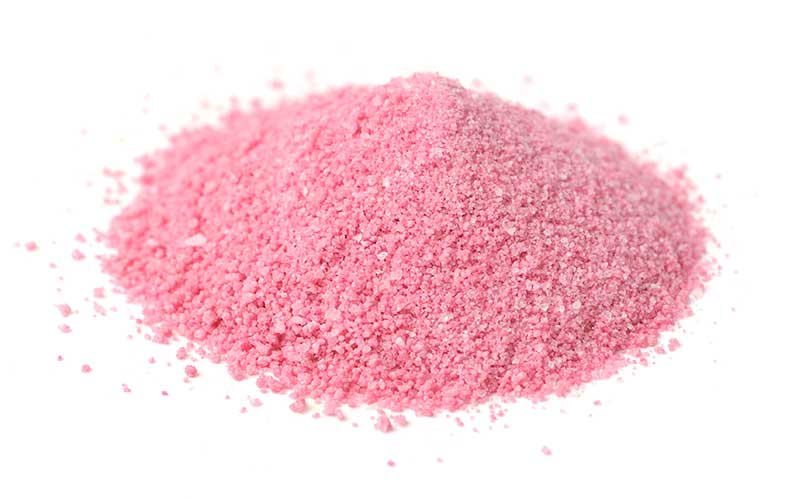What Is Pink Cocaine? | What To Know About 2C-B

Medically Reviewed By: Manish Mishra, MBBS

Written by: Fikret Terzic MD, MS
Pink Cocaine, also called tucibi, is a new drug imported from South America that is likely neither cocaine nor the psychedelic drug 2C-B. Rather, it is a mixture of an aromatic pink powder with various drugs of abuse, creating an unpredictable, dangerous, and addictive recreational party drug.

Cocaine hydrochloride is a natural stimulant produced from the leaves of the coca plant in South America. While pure cocaine takes the form of a glossy white powder, the color and texture of street cocaine can vary considerably depending on the additives and adulterants cut into it.
So-called ‘pink cocaine’, on the other hand, is a slang term that doesn’t actually refer to cocaine at all. Instead, pink cocaine references a stimulant designer drug or drug cocktail being used in certain nightlife scenes in Europe and the Americas.
2C-B/Nexus
2C-B is a psychedelic phenylethylamine drug traditionally produced as a white powder, sometimes pressed into tablets or gel caps. It is known scientifically as 4-Bromo-2,5-dimethoxyphenethylamine.
It was first synthesized by Harvard organic chemist Alexander Shulgin in 1974 and, much like MDMA, was used experimentally in therapy and medicine. In fact, for a period of time it was marketed and sold under brand names like Nexus, Performax, and Erox as a libido enhancer and treatment for erectile dysfunction.
2C-B was also widely used as a recreational party drug in the United States and Europe, especially after MDMA/ecstasy was banned in 1985.
Determining that 2C-B had a high potential for abuse and no meaningful or accepted medical use, the DEA classified the drug as a Schedule I controlled substance in 1995, meaning that it is now illegal to possess in the United States.
Tucibi/Pink Cocaine
Recently, a new and highly popular version of 2C-B has spread from clubs and raves in Central and South America to the United States and Europe.
First used in Medellin, Colombia, this form of 2C-B was mixed with an aromatic food coloring, creating a distinctive bright pink powder that could be more comfortably used by snorting.
But because genuine 2C-B was expensive and difficult to source from Europe, South American cartels and drug traffickers quickly began to cut their supplies heavily, diluting and soon replacing 2C-B with a varying and unpredictable mixture of substances.
This mixture has allegedly included LSD, ketamine, MDMA, caffeine, tramadol, cocaine, amphetamine, methamphetamine, benzodiazepines, cathinones, hallucinogens like mescaline, and even the hyper-potent and often deadly opioid drug fentanyl.
Slang terms for these popular Colombian drug cocktails include:
- tucibi
- tuci
- tussi
- pink cocaine
Effects Of Pink Cocaine
The effects of pink cocaine can vary depending on the drug’s precise composition, how it is taken, and an individual’s tolerance and physical reactions. Using alcohol or other drugs at the same time can also have an impact.
Small doses tend to have stimulant effects, including increased heart rate, sensory stimulation, and mild euphoria. Larger effects will increase until they become intense or severe.
A very wide variety of other side effects are also possible, as each producer of pink cocaine generally uses a different recipe, leading to samples with different strengths, effects, and risks. Toxic overdoses and medical emergencies are therefore likely.
As a general point, the effects of the pink cocaine peak within 1-3 hours and last for between 4-8 hours.
Side Effects Of Pink Cocaine
As pink cocaine typically includes a potent stimulant paired with an opioid or other drug, the potential side effects tend to include (but are not limited to) those of stimulant drugs.
These can include hallucinations, nausea, agitation, hyperthermia, seizures, or even a rare condition known as excited delirium, which can cause cardiac arrest and death in turn.
Long-term, pink cocaine use may cause severe cardiovascular damage and cognitive effects impacting sleep, personality, perceptions, memory, thinking, mood, and overall mental health.
Addiction, tolerance, and withdrawal symptoms are all also very likely to develop if use of the drug continues.
Cocaine Vs. Pink Cocaine
Pink cocaine and street cocaine are different in many ways, as cocaine is a natural substance extracted from the leaves of the coca plant while pink cocaine is predominantly a synthetic drug or mix of drugs.
Yet these drugs also share many similarities, including that they are both:
- illegal substances created outside of medical or governmental oversight
- heavily cut with other drugs and fillers
- often desired as status symbols
- associated with both upper-class, celebrity nightlife as well as common street use
- highly addictive and harmful with long-term use
Cocaine addiction, whether you are dealing with traditional cocaine or pink cocaine, is a treatable medical condition.
To learn about our cocaine addiction treatment options, please contact the Ohio Recovery Center today.
- Department of Justice — Information Bulletin 2C-B (Nexus) Reappears on the Club Drug Scene https://www.justice.gov/archive/ndic/pubs0/665/index.htm
- InSight Crime — Tusi: The Pink Drug Cocktail That Tricked Latin America https://insightcrime.org/news/tusi-the-pink-drug-cocktail-that-tricked-latin-america/
- Journal of Medical Toxicology — 2C or Not 2C: Phenethylamine Designer Drug Review https://www.ncbi.nlm.nih.gov/pmc/articles/PMC3657019/

